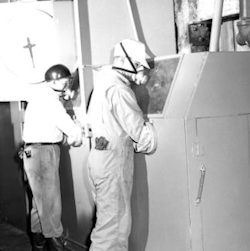Engineering Controls
Engineering measures include local and general exhaust ventilation, process and equipment modification, material substitution, component replacement, and isolation or automation.
Exhaust Ventilation: Equip power tools used to remove lead-based paint with dust collection shrouds or other attachments so that paint is exhausted through a high-efficiency particulate air (HEPA) vacuum system. For operations such as welding, cutting/burning, or heating, use local exhaust ventilation. Use HEPA vacuums during cleanup operations.
Containment enclosures: For abrasive blasting operations, build a containment structure that is designed to optimize the flow of clean ventilation air past the workers' breathing zones. This will help reduce the exposure to airborne lead and increase visibility. Maintain the affected area under negative pressure to reduce the chances that lead dust will contaminate areas outside the enclosure. Equip the containment structure with an adequately sized dust collector to control emissions of particulate matter into the environment.
Enclosure or encapsulation: One way to reduce the lead inhalation or ingestion hazard posed by lead-based paint is to encapsulate it with a material that bonds to the surface, such as acrylic or epoxy coating or flexible wall coverings. Another option is to enclose it using systems such as gypsum wallboard, plywood paneling, and aluminum, vinyl, or wood exterior siding. Floors coated with lead-based paint can be covered using vinyl tile or linoleum.
Process or equipment modification: When applying lead paints or other lead-containing coatings, use a brush or roller rather than a sprayer. This application method introduces little or no paint mist into the air to present a lead inhalation hazard. Click on the button below for some examples.
- Use non-silica-containing abrasives such as steel or iron shot/grit sand instead of sand in abrasive blasting operations when practical. The free silica portion of the dust presents a respiratory health hazard.
- When appropriate for the conditions, choose blasting techniques that are less dusty than open-air abrasive blasting. These include hydro- or wet-blasting using high-pressure water with or without an abrasive or surrounding the blast nozzle with a ring of water, and vacuum blasting where a vacuum hood for material removal is positioned around the exterior of the blasting nozzle.
- When using a heat gun to remove lead-based paints in residential housing units, be sure it is of the flameless electrical softener type. Heat guns should have electronically controlled temperature settings to allow usage below 700 degrees F. Equip heat guns with various nozzles to cover all common applications and to limit the size of the heated work area.
- When using abrasive blasting with a vacuum hood on exterior building surfaces, ensure that the configuration of the heads on the blasting nozzle match the configuration of the substrate so that the vacuum is effective in containing debris.
- Ensure that HEPA vacuum cleaners have the appropriate attachments for use on unusual surfaces. Proper use of brushes of various sizes, crevice and angular tools, when needed, will enhance the quality of the HEPA-vacuuming process and help reduce the amount of lead dust released into the air.
Isolation: Although it is not feasible to enclose and ventilate some abrasive blasting operations completely, it is possible to isolate many operations to help reduce the potential for lead exposure. Isolation consists of keeping employees not involved in the blasting operations as far away from the work area as possible, reducing the risk of exposure.
Knowledge Check Choose the best answer for the question.
2-3. Using local exhaust ventilation for operations such as welding, cutting/burning, or heating is an example of _____.
You forgot to answer the question!

